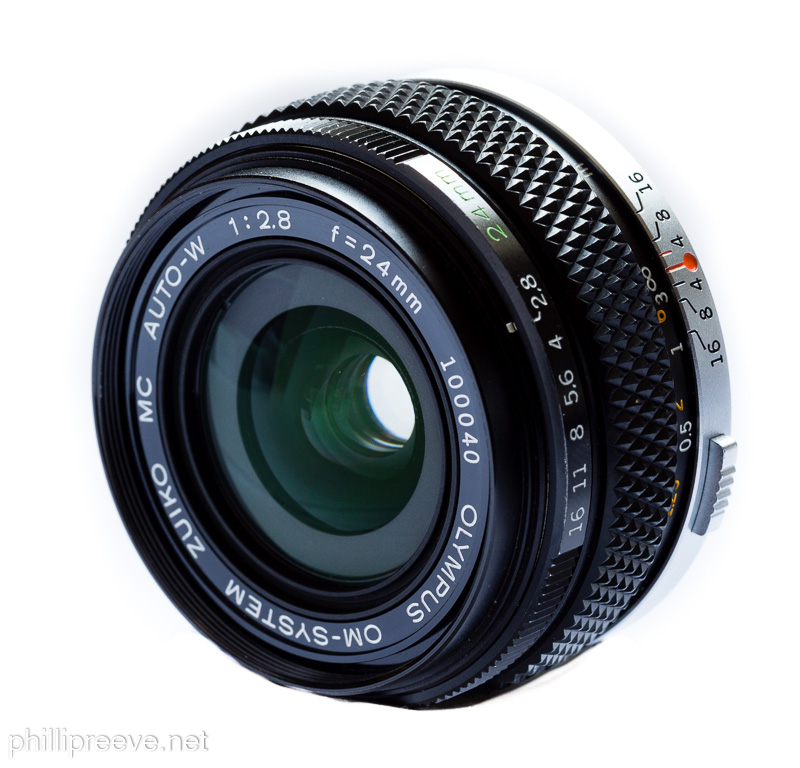
Image Samples
You can find most of the images in this review in full resolution in this Olympus OM 1:2.8 24mm flickr set.
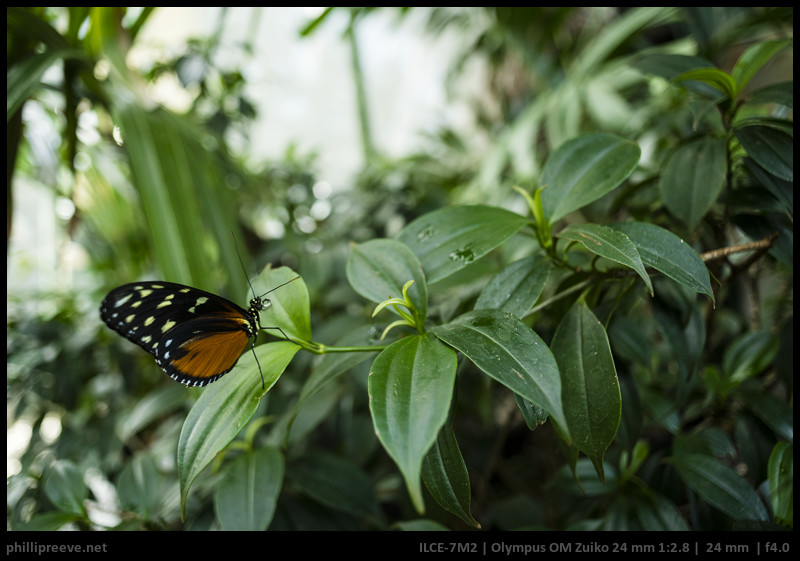

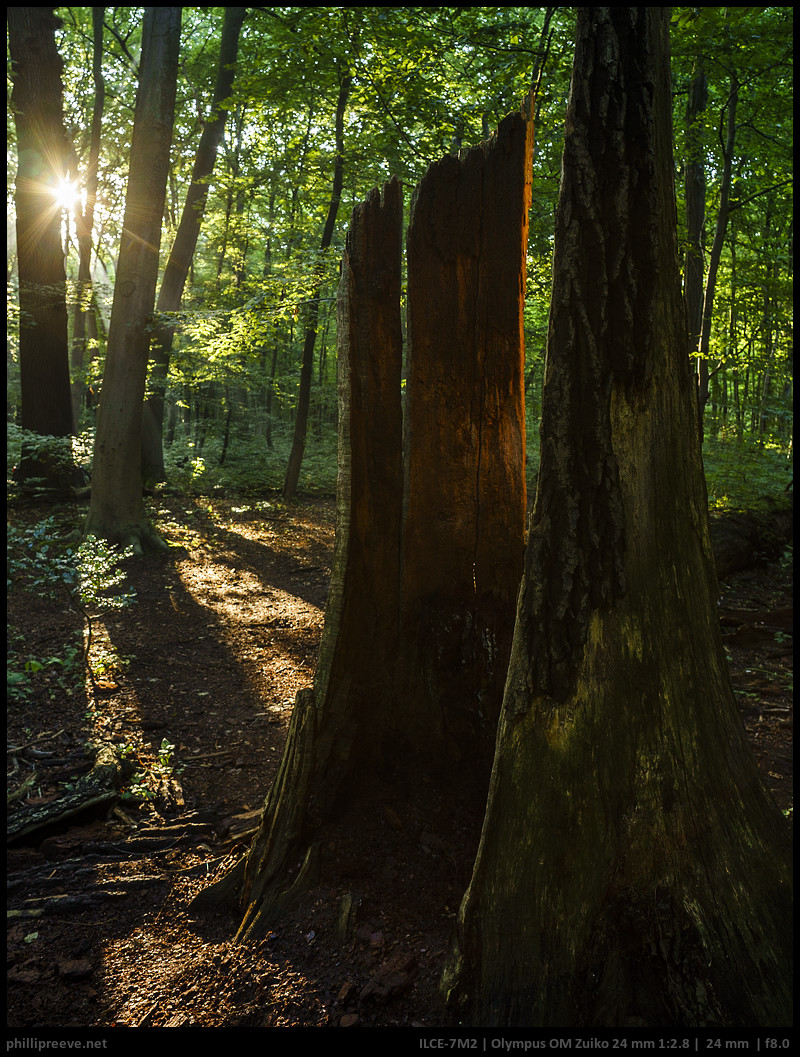
Specifications
| Diameter | 60 mm |
| Length | 31 mm |
| Filter Thread | 49 mm |
| Weight | 180 g |
| Max. Magnification | 1:7 |
| Close Focusing Distance from the sensor | 0.25 m |
| Number of aperture blades | 6 |
| Elements/ Groups | 8/7 |
Versions
For practical purposes I see three versions of the Olympus OM 2.8/24:
- The Olympus OM H.Zuiko Auto-W 1:2.8 f=24mm is single coated which is why I wouldn’t recommend it and there are versions with “silver nose” and without.
- The Olympus OM Zuiko MC Auto-W 1:2.8 24mm shares the optics and mechanics of its predecessor but it is multi coated. This is the version I own.
- The last version is the Olympus OM Zuiko MC Auto-W 1:2.8 f=24mm. The MC was dropped from the name but that is the only change.
All three versions share the same optics but I would recommend to stay away from the first version (no MC in the name, H.Zuiko and f=24mm) because my experience with single coated Olympus OM lenses is that they flare a lot. I see no practical difference between versions two and three.
Data according to Olypedia.de
Build quality and handling
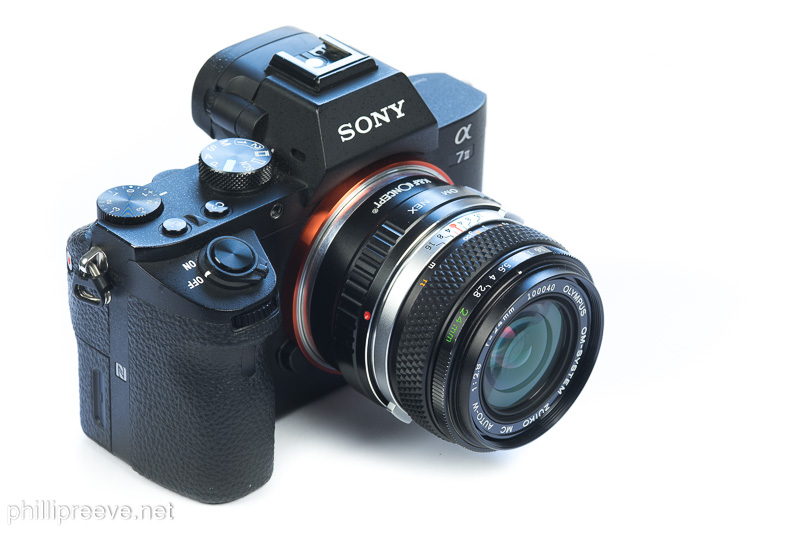
Olympus OM lenses usually combine a very small size and great handling. The Olympus OM 2.8/24 is no exception.
Focusing Ring
The focusing ring travels around 65 degrees from 0.25 m to 1 m and a further 15 degrees to infinity. This is a little steep for a wide angle but not much of an issue.
The rubberized focusing ring offers good grip and a pleasant diameter. The resistance is pleasant and a little on the low side on my copy. My copy has had a CLA recently so I don’t know if other copies will have a similar resistance.
Aperture
The aperture ring sits at the front of the lens and it has full stops from f/2.8 to f/16 which click into place very nicely. I think this is one of the best aperture ring designs I have come across.
Hood
I don’t own a hood for it but it would make sense to get one since the front lens is quite exposed and flare an issue.
Size and Weight
At 180g and with a length of just 31 mm the Olympus is very small but still large enough to be very pleasant to handle and very well balanced on the a7 series.

Optical performance
These results are based on the use with a Sony Alpha 7/7II.
Flare Resistance
Flare is definitely an issue with this lens. If you have a stronger light source in the image you get a very big ghost and veiling flare in a large area of the image. For me this is a limiting factor since I like to shoot backlit scenes.
I lifted the shadows in the image above, if you don’t lift them the flare issues aren’t very noticeable.
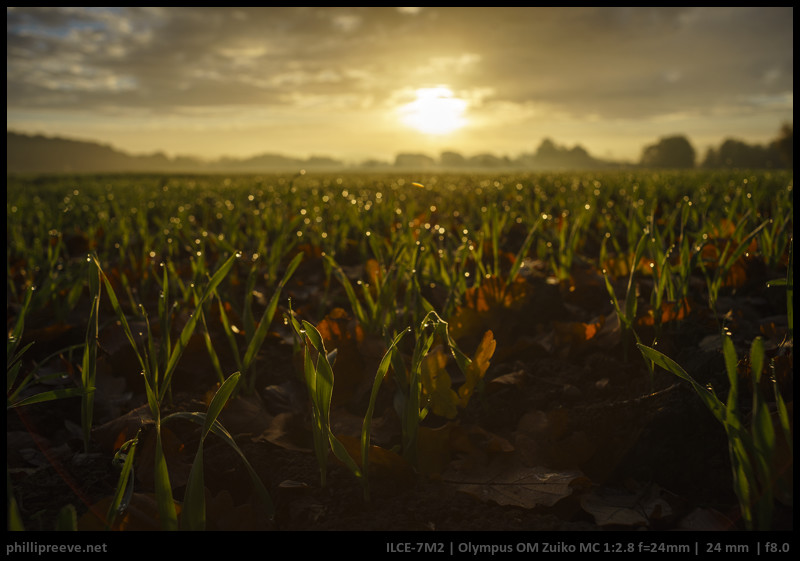
Without the hood I sometimes got strange red ghost in the corners. These could be eliminated by shading the front of the lens with my hand but I haven’t noticed such a behavior in any other lens before.
Bokeh
Classic wide angle lenses usually have rather busy bokeh and the Olympus OM 2.8/24 is no exception here.
At f/2.8 out of focus highlights are rendered busy with a defined edge and towards the corners cat-eyes appear. Stopped down to f/5.6 bokeh is smoother but the hexagonal shape of the aperture becomes visible.

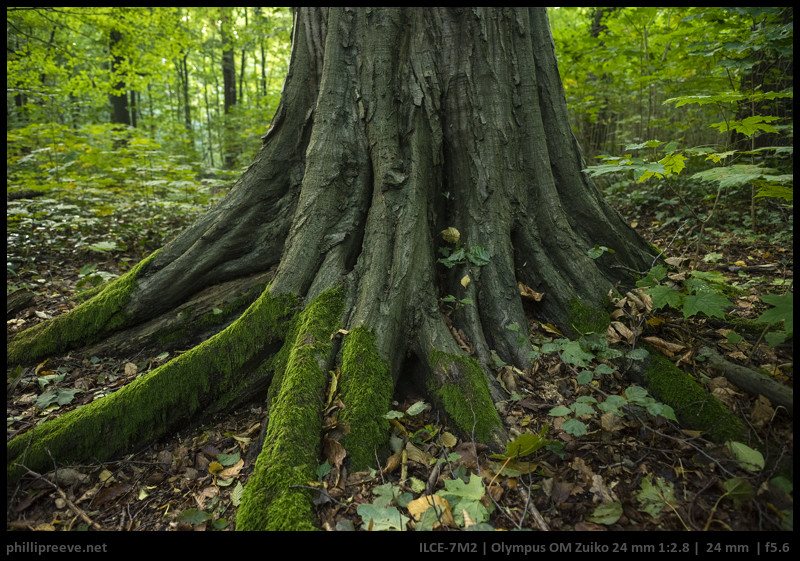
Chromatic Aberrations
Axial CA are corrected very well, even in my worst case test there are hardly any CA to be noticed:

Lateral CA on the other hand is moderate to strong which is a good performance for a 24mm lens of this age but you want to auto correct CA

Vignetting
How can the Olympus OM Zuiko 24mm 1:2.8 be so small? Because it allows for a high amount of vignetting. At f/2.8 I measure a whopping 2.8 stops on my Sony a7ii, 2.2 stops at f/4, 1.8 stops at f/5.6, 1.6 stops at f/8 and f/11. There is also some slight color-shift.
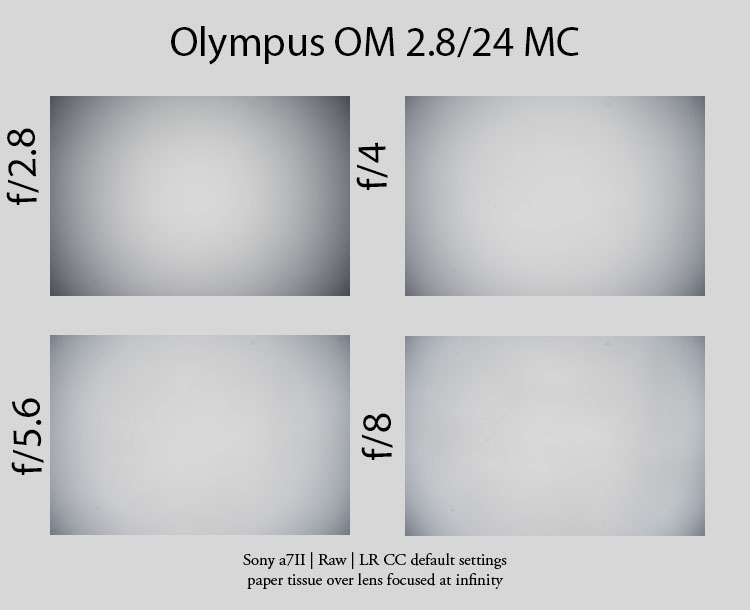
Since vignetting is not gradual but happen rather sudden in the corners I often had images of blue sky with visibly darkened corners.
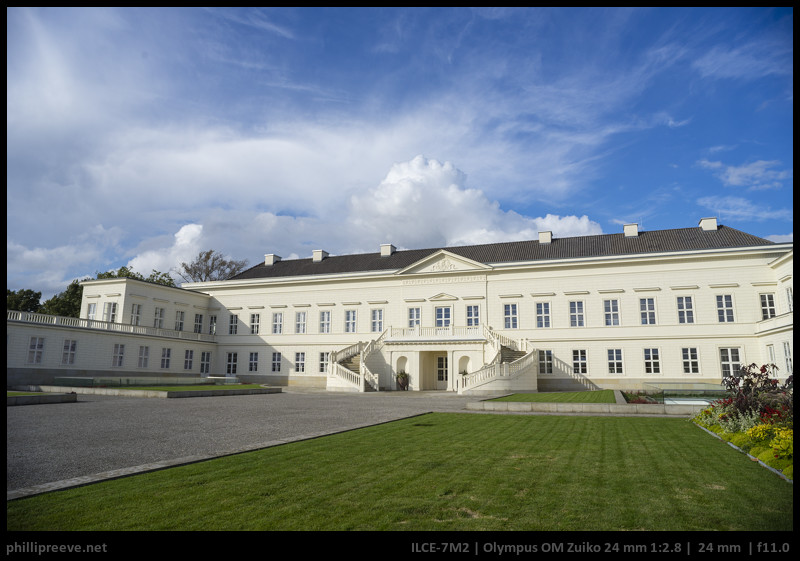
Distortion
The Olympus OM 24mm f/2.8 shows a low amount of distortion for a wide angle but since it is complex mustache distortion I can’t fully correct it in LR. Still probably low enough that hardly anyone would notice for architecture though.
before: no correction | after: corrected with a +5 settingSharpness
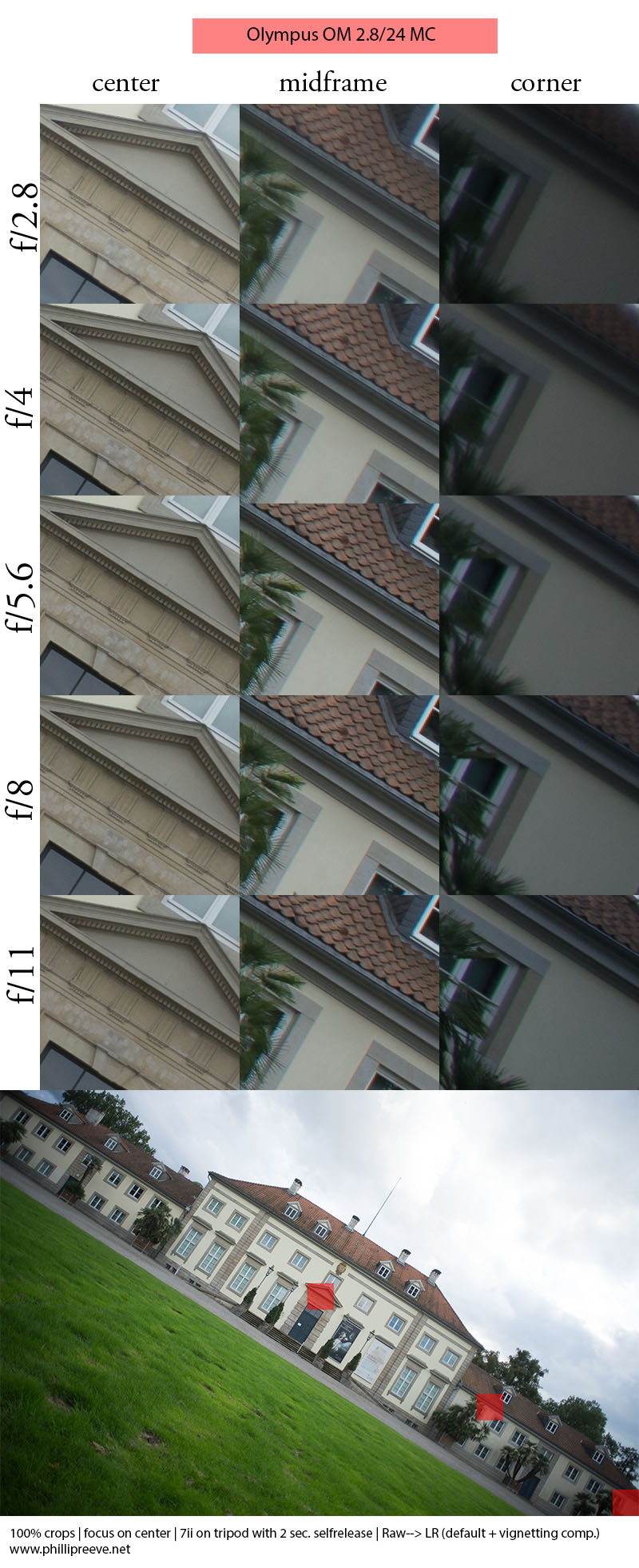
f/2.8: Very good in the center, good to ok in the midframe area and okayish with lots of spherical aberration in the corners.
f/4: Excellent in the center, good to very good in the midframe area and not much better in the corners.
f/5.6: Very good across most of the frame but the corners still have low contrast and only okay sharpness.
f/8: Now even the corners are good.
f/11: A tad softer in the center but the corners gain some sharpness.
As long as your subject is in the center images are very sharp from wide open. For off-center compositions I would recommend f/5.6 for very good results and for across the frame sharpness you need to stop down to f/8 where it performs on a high level.
At the close focusing distance I only checked sharpness in the center but here it shows very good performance from wide open with only a marginal gain in sharpness if you stop down.
Alternatives
Canon nFD 2.8/24: The cheaper Canon is a bit larger and build quality is inferior. I would say optical performance is similar. Sharpness is quite comparable, the Olympus has a bit less distortion but a lot more vignetting. Choose the Olympus when size is your priority, otherwise the Canon is probably the smarter choice.
Minolta (plain) MD 2.8/24: My favorite legacy 24mm lens right now. Build quality is not great but better than that of the Canon. I think it performs a bit better against sun than the Olympus and it has no vignetting issues. Sharpness is similar.
Sony FE 4/16-35 ZA OSS: About 2.5 times the weight, many times the size, about 10 times as expensive this modern zoom is not nearly as pleasant to handle but significantly sharper at wider apertures. At typical landscape apertures the ZA is still a bit sharper but not by much. More noticeable is the higher contrast but that can be added in post to some degree.
pros
|
average
|
cons
|
Optically the Olympus OM Zuiko 2.8/24 MC comes with a number of compromises: For good across the frame sharpness you need to stop it down to f/8 or even better f/11. Flare resistance isn’t very good either and vignetting is unusually high. This limits its usefulness but if you take the shortcomings into consideration the Olympus can give you very good results for little money.
I have very little but praise for the mechanics and the handling of the OM 2.8/24. It is built to high standards and both focus- and aperture ring are pleasant to use. Since it is so small it is a good choice for any small kit on a budget.
All in all I am a bit reserved about recommending the Olympus OM 2.8/24: It has shortcomings which limit the applications you can use it for. But since it is rather cheap and very small it can still make good sense in your kit because for some applications it performs very well.
The Olympus OM 2.8/24 usually sells for around $100 used at ebay.com or around 130€ at ebay.de (affiliate links).
If this review was helpful to you, please consider using one of my affiliate links. Thanks ?
Images Samples
You can find these and more images in full resolution in this flickr set: Olympus OM 1:2.8 24mm.
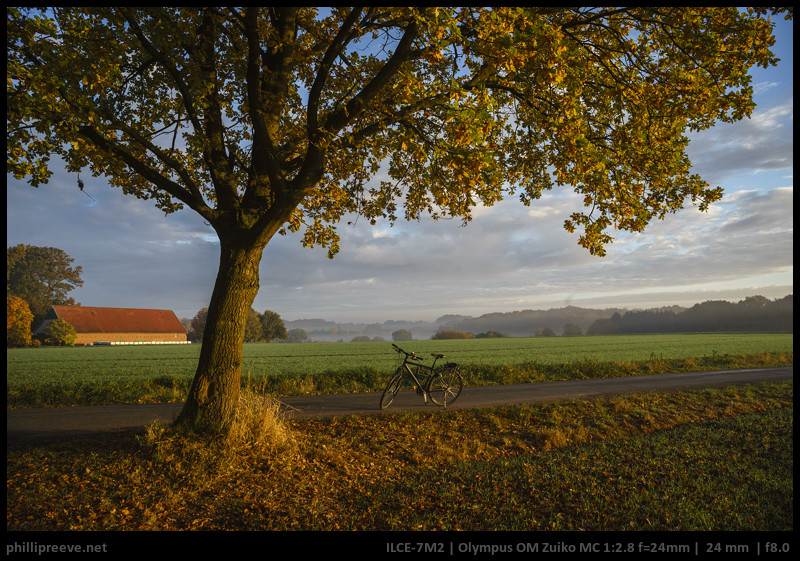
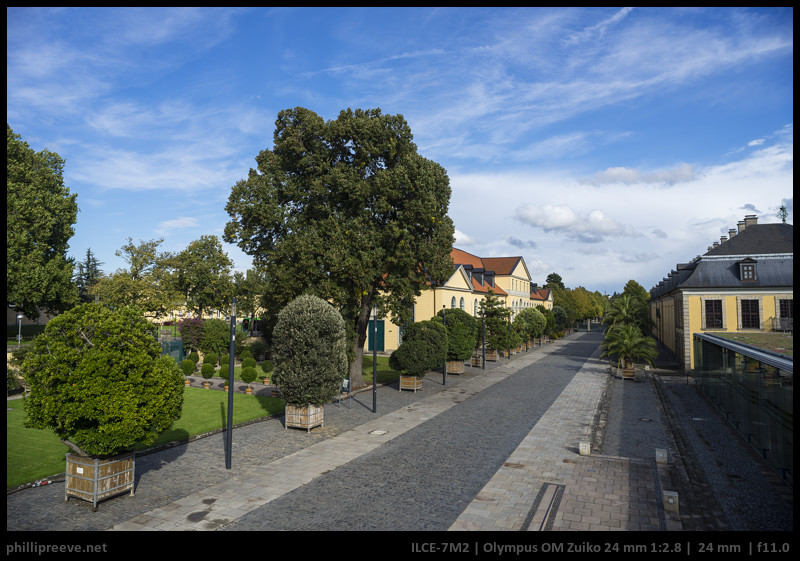
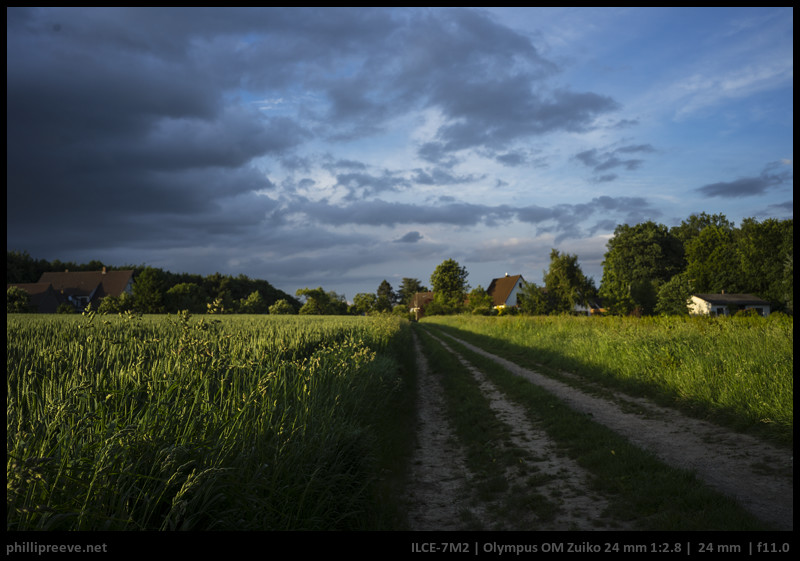
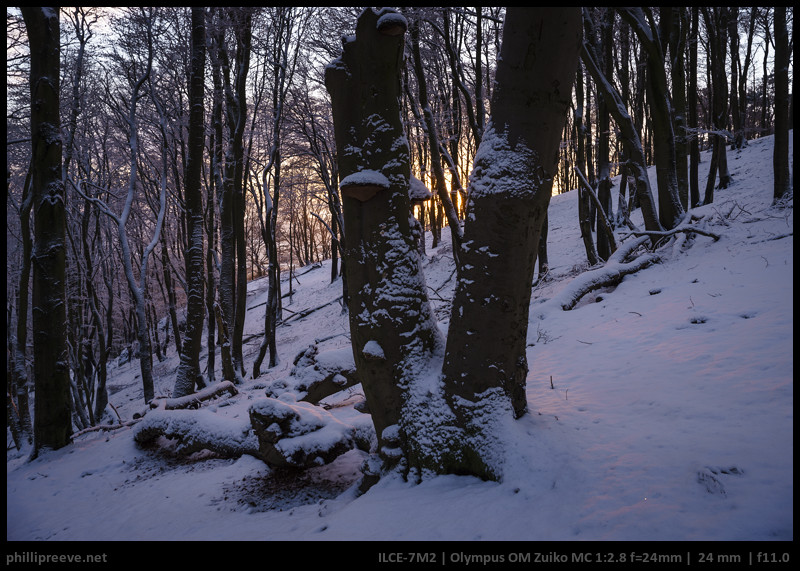
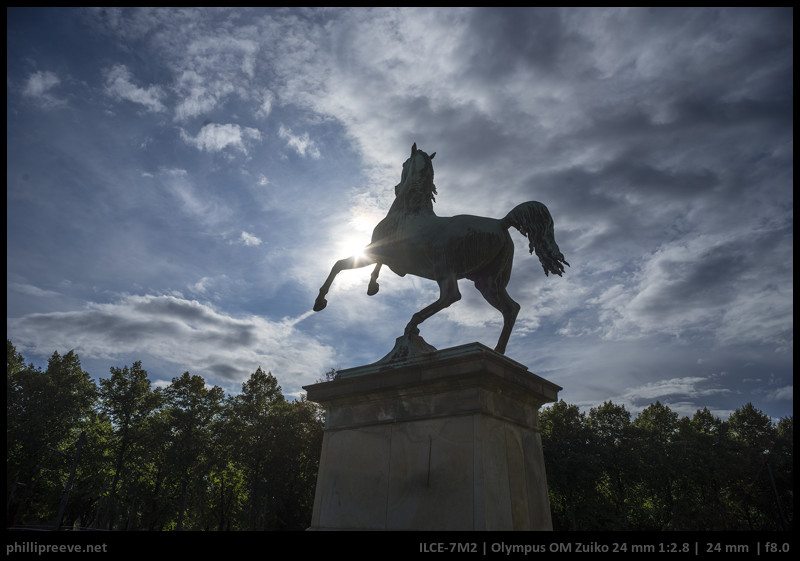
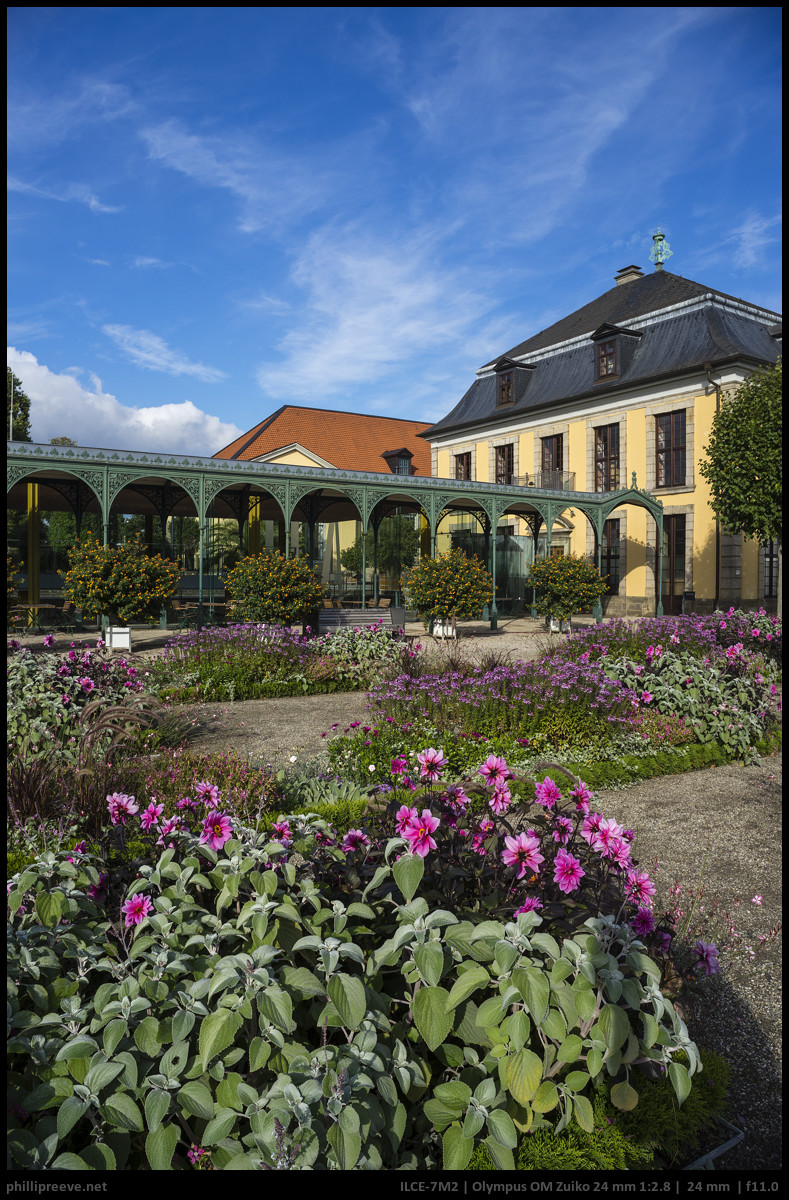
Other articles
- Short Review: Olympus OM Zuiko MC 100mm 1:2.8
- Affordable manual lenses for the Sony Alpha 7 series
- Review: Sony FE 2.8/50 Macro
- Tokina AT-X Macro 90mm 1:2.5 Review
This site contains affiliate links. If you make a purchase using any of the links marked as affiliate links, I may receive a small commission at no additional cost to you. This helps support the creation of future content.
Latest posts by Phillip Reeve (see all)
- Review: Samyang AF 75/1.8 FE - April 12, 2021
- The FE-List now has 113 lenses on it - March 25, 2021
- 2020 – Year’s end review - December 28, 2020




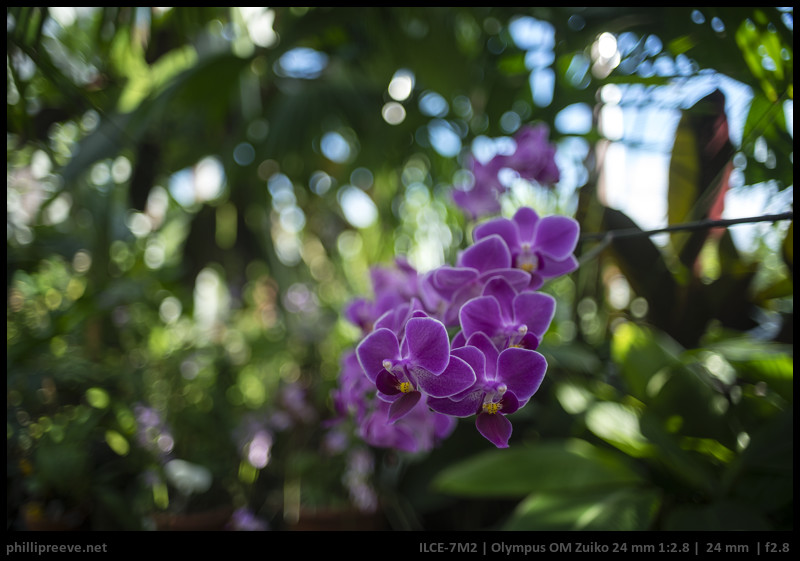



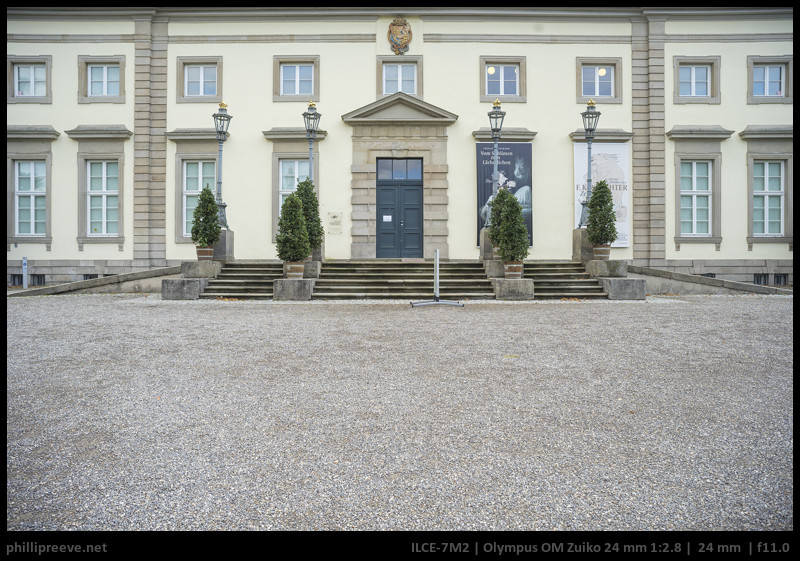
For sharpness it’s my favourite in MF lenses, though the Canon TS-E 24/2.8 MkII is supposed to be slightly better…in fact the sharpest 24mm in MF. (My MD 24/2.8 has worse corners, and I found the FDn to have “muddy” colours, though as you say, about equal sharpness.)
Both the OM 24/2.8 and 21/3.5 can exhibit that unusual “red-ring” flare, and as you stated, the single coated version is worse for it.
For me, only the sharp vignette is a nuisance, as I usually manage to flag off the sun, (not in frame obviously.)
In comparison with my new, AF Batis 25, this OM is its equal for sharpness, (when closed down to F/8-11), though not for bokeh or flare control.
Thanks for your input Tim 🙂
I have both. The canon T/s 24 is almost flawless: Sharp, minimal distortion (my distortion correction software simple says “not needed”), no vignetting at center shift, and of course it can tilt and shift. It is remarkable.
Of course it is nearly 10 times the size of the Olympus, and the Olympus has a jewel like beauty.
I can only confirm.
If corner sharpness matters, landscapes, architecture etc…the Zuiko is a very bad choice. I sold mine, even at F8, corner sharpness was meh.
The Canon 24mm TSE II is not only “supposed to be slightly sharper”, it is actually tons sharper, doesn’t exhibit flare, CAs, or distorsion.
Comparing the two lenses comes down to comparing a mediocre and an excellent lens.
Great review, thank you ! When i look at the size of this lens, I want to cry when i compare it to the modern lenses. Look how cute it looks, so small, light, imagine it without any extension tube. damn shame nobody is making suchm, except from loxia but that is too expensive. and no 24mm
For interest, the “red-ring” flare, is shown on link below, on the OM 21/3.5, with single coated cf. multi coated.
The 21/3.5 has very similar character to the 24/2.8, right down to the sharp vignette.
http://www.stefanrohloff.de/20_olyspecial.php?en=1
Excellent review, as alway. Thank you. I own and sometimes carry this lens. You described it very accurately.
For my purposes, this lens is worth owning. I carry it as part of my comprehensive-carry, but it is never in my bag for a normal outing. I have excellent lenses at 21mm and 28mm, and one or both of those are likely to be in my bag and get used on most outings. This OM 24 is so small and light that it’s a no-brainer to add it to the mix just to have the focal length, and I know it will be good stopped down. Since I often have another OM lens with me, I don’t even keep an adapter on this lens, so it is really small and light. (The downside of that assumption of course is that I might be caught without an adapter when I don’t carry another OM lens.)
It’s definitely not: “Ah this is such a great lens it’s on the camera all the time.” No.
Instead: “Better to have a 24mm lens with me that might be pretty good stopped down than not have one at all.”
I carried it around Iceland for two weeks last summer and it was the one lens I didn’t use at all. I probably would have used it if I had packed the 49-52 step up ring for my 52mm ND filter at waterfalls and tighter places, but in general use the trade off of precise focal length over lens quality didn’t favor the use of this lens in what I considered important use. I didn’t mind much that I carried it without using it because it was so tiny.
I have more than once packed a lens and forgot to pack the adapter as well 😉
Excellent review as ever, thank you. I like this lens for the reasons you give. It does need a hood and one from the Takumar 3.5/28 fits very well. You can reverse it to retain the compactness in your bag and I add a 49 mm filter ring with the glass removed to aid mounting.
thanks for the tip 🙂
Anyone knows if the mentioned Pentax 28mm 3.5 49mm rectangular hood would cause vignetting for the Olympus 24mm 2.8 on full frame? Thanks
I am using a FOTGA digital adapters OM-NEX adapter in combination with Olympus OM Zuiko lenses 50mm 1.8 and 50mm 1.4. Both lenses have the same problem when turning the aperture ring. It only reliably works until 5.6. Then the aperture turns sort of sluggish for 8-11-16 by not further closing the blades properly. I verified it with the stop down button on the right of the lens. Pressing and releasing this button will further close/open the blades to the apparently correct value. First I thought it might be adapter related. Then I cross compared this finding with a Tokina lens OM mount which worked fine without the need to press down the button on the right. Now I believe it is Olympus lens related as I also have a third Olympus 35-70mm zoom lens showing the exact same problem. Any wizard here who knows the tricks as I am new to the world of Olympus manual focus lenses and would like to enjoy them too? (but please without the need to press down a button)
Hi Carlo,
there is a little metal nose at the mounting size of the OM lenses which is related to the aperture blade mechanism. By mounting the lens on the adapter this nose should be at the end of the small slit where the metal nose is installed. Otherwise you will see the problems when turning the aperture ring. Maybe you can correct the counterpart’s position of this metal nose at the adapter side. I’m using the novoflex and the K&F adaptors which are working well with my OM lenses.
I have got a similar problem with the Fotga adaptor. It is the adaptor problem as all my Zuiko lenses have problems with the aperture closing. DO NOT BUY FOTGA OLYMPUS TO NEX ADAPTORS BECAUSE THEY ARE FAULTY!
Thanks for you review.
As far as I know, the “MC” version was only made for a short period of time. I have only seen the “MC” version with serial number 18xxxx and 19xxxx.
Serial number less than 17xxxx are the H.Zuiko.
Serial number greater than 20xxxx are the Zuiko without “MC”.
It is surprising you have a 10xxxx with “MC”.
My copies of the “MC” in 18xxxx – 19xxxx range are equal or better than my copies of the Canon FDn 24/2.8, the Canon FDn24/2, and the Minolta MD 24/2.8 at nearly all apertures.
I have a copy with serial number 198xxx that does NOT have the “MC” designation.
And thank you to Phillip for a very interesting and informative site.
Best regards,
Lars Molte Jakobsen
I have the last version of Zuiko 24/2.8, But there is a big field curvature problem: if I make a landscape photo at f/8 with focus on the center, the corners are always mediocre at best. But if I focus on the corners (I have to fly over infinity on the center a bit), then the center sharpness is bad. I have a K&F Pro Adapter on Sony A7R II. What is your experience in this regard?
A very accurate and interesting review of the OM 24mm.
Very well written indeed.
Best regards
Svenning Bjerregaard Jensen,
Denmark.
Nice review!
One online source says that the third version (without the MC) had a slightly simplified optical scheme, sacrificing a bit of quality.
In my own experience, the one sample of type III I tried was indeed noticibly less sharp in the corners than the type I & MC versions.
Some people say the 24 2.8 has a lot of sample variation, so what I noticed could be due to that.
Thanks for your input 🙂
I hav not tried this “multi coated” lens, I had Olympus F.Zuiko 24mm f2.8 and compared it with Canon fdn 24mm f2.8 on Sony A7rii. The edges and corners are much cleaner with the Canon. But I sold them all, and now I use Loxia 21mm f2.8 and crops the picture to gain 24mm and similar, at least when shooting landscapes.
if you can only own one vintage uwa lens (under $200 used), which would you choose? (from 17mm-24mm)
Minolta MD 2.8/24 (non Rokkor) or Canon FD 2.8/20
thank you !
Phillip, Are you referring to the later, smaller version of the Minolta? Sorry I find the Minolta lenses confusing. Thanks for the review. Simon.
Yes, I do.
I have the single-coated version I am quite surprised that your multi-coated version exhibits similar flare issue as my single-coated version. I hate the large hexagonal flare! But then I use this quite often because of its compact size
Interesting review, which proves, again, that sample variations is a huge issue. I tried this lens on the A7r for a short time and if it wasn’t for the standard Olympus cyan tint (which makes matching my EF glass harder than it needs to be) I’d have kept it.
I found the corners better than you have on the A7. It was also vastly superior to the poorer of my two copies of the Canon FDn and clearly superior to the other.
It’s an excellent lens, but very difficult to focus. Usually only the focus area is sharp, I don’t know why. But my lens is excellent because I have a few pictures tack sharp from edge to edge… Probably better on tripod !
What keeps me interested in Zuiko OM lenses is that very interesting colour and contrast rendition. I don’t like Canon FDn lenses at all, because of an awful plasticky focusing experience and muddy colour rendition. Sharpness is really good though.
Concering the “red ring” flare: I can’t comment on the 24, but I have a 21/3.5 in the last version with a high serial number (120xxx) which doesn’t show the red ring at all.
Olypedia.de and several other sources mention a mysterious late “NMC” coating. Maybe that’s the reason. My 21/3.5 coatings look very green, other than the red/blue MC coating e.g. on my 50/1.8 (No. 2 million xxxx).
Rgds, Robert
Hello.
Thanks for the review.
There appear to be inconsistencies in OLYPEDIA for the 24 2.8.
The list 4 versions, none of their pictures include ‘MD’ engraved.
Your version SN 100040 is lower than OLYPEDIA’s first version.
With yours, apparently there are 5 versions.
Do you have to share the correct versions and specifications?
Do you mean MC?
A lot of this is guesswork by people. Viewed externally we know of four: h.zuiko silvernose, h.zuiko black nose, Zuiko mc and Zuiko. No one has definitive information on how these external things correlate with optics and coatings, though there are good guesses.
Hi everybody!
I would like to ask if somebody has tried the OM Zuiko 24mm F 2 and can share it’s impressions. I’ve heard that in it’s time was a respectable lens; however after using it on Sony A7II, it’s sharpness does not impressed me too much. It’s just ok, uniform from center to corner at f 5,6 but cheaper lenses do better in the center.
Maybe it’s a defective copy? Optics are clear and there are not sign of fungus ecc.
Probably not a defective copy. Tested the Zuiko 24mm f2.0 vs. Zuiko 24mm f2.8. Kept the f2.8, sold the f2.0. Also tested the Zuiko 35mm f2.0 vs. Zuiko 35mm f2.8. Kept the f2.8, sold the f2.0. If you don’t need the extra speed/ bokeh, the smaller versions are (often) the better ones. With camera’s such as Sony A7s, who needs speed anyway?
In various tests back in the day the fast 24 and 21 tested the same, better than, or worse than, their slower sisters. Which makes me think it’s just variation, and they were designed with the same resolution target. Since the bokeh is. It great with those heavier and more expensive wides wide open, I agree it makes sense to get the smaller ones.
If you are shooting film, the extra speed makes a little bit easier to focus, but I still wouldn’t put ups with the cost and weight just for that.
The latest version of the lens (zuiko without ‘mc’) does have a different design compared to the previous versions: the rear elements behind the aperture are slightly smaller in diameter. This results in more vignetting (especially visible at f2.8) and a bit less good corner performance. However the coatings are a bit better, and the colour is colder/ more neutral.
I’m pretty sure some later H.Zuiko lenses do have multicoating. My copy clearly does. Improving on coatings is an ungoing process, it is very unlikely Olympus started producing multicoated versions of a lens from one day to another. The addition of ‘MC’ in the name of the lens has to do with marketing. On the other hand, if the lens says ‘MC’ one can be sure about it 😉
Thanks Bas
(1J I have heard this claim about the 2.8/24 before, but never seen definitive proof. Can you show it to me? That would be interesting! I tested a late one against the earlier MC and the late had better corner performance, but this doesn’t mean you are wrong statistically as it could be down to sample variation.
(2j It’s hard to know if a lens is multicoated. MC meant that all the surfaces were multicoated. I think in the x.zuiko days, many lenses had *some* multicoated surfaces, and single coating elsewhere, at some point in their run. It’s very hard to tell by inspection if a lens is MC if the outer surfaces are multicoated.
Hi David,
1. I have to confess I jumped to conclusions after reading a comment about it in another review. It mentions the first two lenses behind the aperture are smaller in diameter, but for proof I have to take the lenses apart, which I prefer not to do… the comment also claimed the impact on corner sharpness. This I can factcheck at the moment 😉
Just tested the H.Zuiko against the Zuiko version and you’re right; the Zuiko does have better corner performance. Actually, at f2.8 corners are already reasonably sharp. Since we both tested better corner performance the chance that it has to do with sample variation becomes smaller. So I guess the design might indeed have been changed BUT improved with that last version!
2. It is hard to know indeed, and the 24mm is such a nice contrasty lens that it really doesn’t matter that much to me. The use of a hood probably has a bigger impact in most cases.
Thanks for doing that test, Bas!
Great to have an extra data point! So slightly more likely that that other person had a poor late one.
Of course it remains possible that the earlier one is on average better, but it’s looking unlikely. And in general when OM ZuikoS were redesigned the later ones were sharper and contrastier, sometimes significantly.
I’ve just today been testing a very late 2.8/35 which is performing much, much better than the two OM 2.8/35s I have tested before, which makes me think it’s more likely it had optical changes for the last version than when I wrote the guide. But as always, it might just be sample variation plus better coatings.
I’ve started to use this lens for stitching panoramas, and so I had to find a way to correct the subtle moustache distortion mentioned in the review, which panorama stitching software often can’t accommodate. Interestingly (and perhaps not too surprisingly) I found that the Adobe correction profile for the Canon 24mm F2.8 IS USM in ACR is a perfect match. However I don’t apply the profile’s vignette correction, and instead I use (in ACR) +10 to +45 (depending on aperture) with “center” set to -100 because the vignette is so concentrated on the far corners.
Another interesting feature of the lens is that even though it is tiny and has vignette which would seem to imply 35mm frame nearly fills the image circle, in fact there is a great deal of “room” within the image circle beyond the 35mm frame if you use the lens on a tilt or shift adapter. It loses sharpness and stops around the edges at a rate that would not be acceptable for a true tilt shift lens, but it still provides interesting and usable results.
Thanks for sharing your experience 🙂
Hi,
I was using this lens on a Canon Eos 80d – works ok , probably world work similiar on Sony too, maybe .this lens is sharp / and made nice. – maybe get an adapter for my sony a7ii -can you recommend a decent one ? , we have om 50mm 1.1..8 – which is alright and this om 24 mm 1.2.8 . Thank you and have good one.
Maybe have a look at our Guide to adapters.
Here’s a custom Lightroom lens profile I made for this lens. Feel free to use and redistribute if you find it useful.
https://cloud.tty9.pl/f/407a7656d898409b8d9f/?dl=1
The olympus 28mm f3.5 is better than this lens, and I tested them, both in the center and the corners.